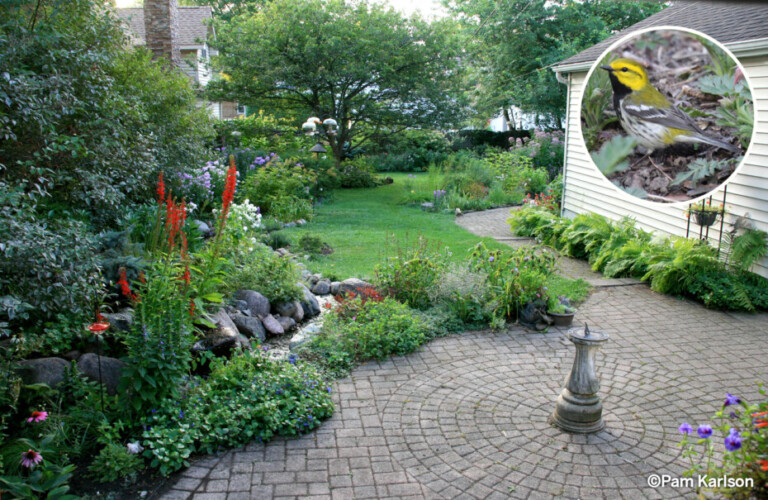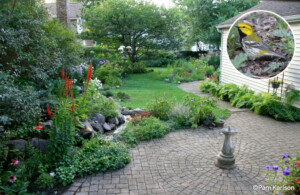
“They also do not provide habitat for the animals that decrease tick infectivity, because they are dead-end hosts for Lyme disease,” and play no role in the disease-transmission cycle. “Our simplified landscapes are not only poor at producing ecosystem services like supporting local food webs, managing watersheds, nourishing pollinators and sequestering carbon,” he said. Typically, HOAs don’t object to that.”Īs for tick worries, creating more native habitat has a benefit there, too. That shows that whatever is beyond that mowed strip is an intentionally designed landscape. “The lawn you keep along the edge of your driveway or sidewalk - again, a cue for care - should be manicured and mowed regularly. “Make those changes in an aesthetically pleasing way,” Dr. Join the active management of the association, and educate from within, or set an example by rethinking your front landscape: Leave some lawn, but add native plantings.

He suggested two approaches to help accelerate that change. “The era of HOA overreaching is ending,” he said. There is a national movement to reduce the power of homeowner associations, he said, citing examples like the May 2021 legislation passed in Maryland that prohibits rules forbidding “low-impact landscaping,” such as habitat-style, pollinator or rain gardens. He regularly hears from those who would like to join the campaign, but are limited by homeowner association covenants that require a mowed front yard. “One reason I don’t say to get rid of the whole lawn is that it’s a cue for care,” Dr.

A bit of lawn conveys that a yard has not been forgotten, but is a landscape with intention that could inspire others. As he points out, grass is functional - “the best plant to walk on without killing it” - and it sends the right signal. He isn’t calling for the wholesale removal of grass. Tallamy said, to “bring the private landowner back into a critically important position in the future of conservation.” Now, in an online Homegrown National Park campaign, participants can commit their land to the movement by joining an interactive map and displaying a sign that tells neighbors what they are doing. His proposal: that a network of individual efforts can add up, and will help to offset the fragmentation of the greater landscape. In his 2020 book, “Nature’s Best Hope: A New Approach to Conservation That Starts in Your Yard,” he challenged readers to help create what he calls a Homegrown National Park. Tallamy, an ecologist at the University of Delaware, encourages us to do better and help regenerate biodiversity by planting more natives.Īnd that means replacing some of our lawn. Keesing speculated that perhaps because pets engage with more of a property than people do, they derive a greater benefit from a decreased tick population.Ĭalling the tens of millions of acres of lawn in America “an ecologically dead status symbol,” Douglas W. But consistent with other studies, reducing the number of ticks did not correlate with a reduction in human disease cases. The bait boxes treated with Fipronil did the best, reducing the total number of ticks by about half, and also reducing the incidence of disease reported in pets. The study involved 24 neighborhoods, and the participating properties in each neighborhood all got one of four treatments (and nobody, including the researchers, knew which one): active fungal spray, active bait boxes, both or neither. The second was Fipronil, a chemical in pet-protection products like Frontline: A baited box held a wick treated with the chemical mice would brush up against the wick, and any ticks that bit them would die. The first was Met52, a spray derived from a naturally occurring fungus that infects ticks. To determine whether reducing the number of ticks reduces human risk, Tick Project team members deployed two products known to be environmentally safe. (In the 2006 study, the space in between, or ecotone, where herbaceous habitat meets forest, had a tick density somewhere in between.) The five-year project involved the participation of some 3,000 people and 1,000 pets in 24 neighborhoods.Ĭonsistent with observations from a 2006 study observing tick density along forest-field edges, the team found fewer ticks in grassy areas than in wooded ones: Ticks were about eight times more abundant in forests than in lawns, across all the properties studied. Ostfeld, a disease ecologist at the Cary Institute of Ecosystem Studies, in Millbrook, N.Y., studied yards in Dutchess County, N.Y., an area with one of the nation’s highest rates of Lyme disease.


Keesing is one of the authors of a recently published study, The Tick Project, which investigated whether reducing the number of ticks in an area necessarily meant reducing the number of tick encounters experienced by humans - and if it decreased cases of tick-borne disease.


 0 kommentar(er)
0 kommentar(er)
